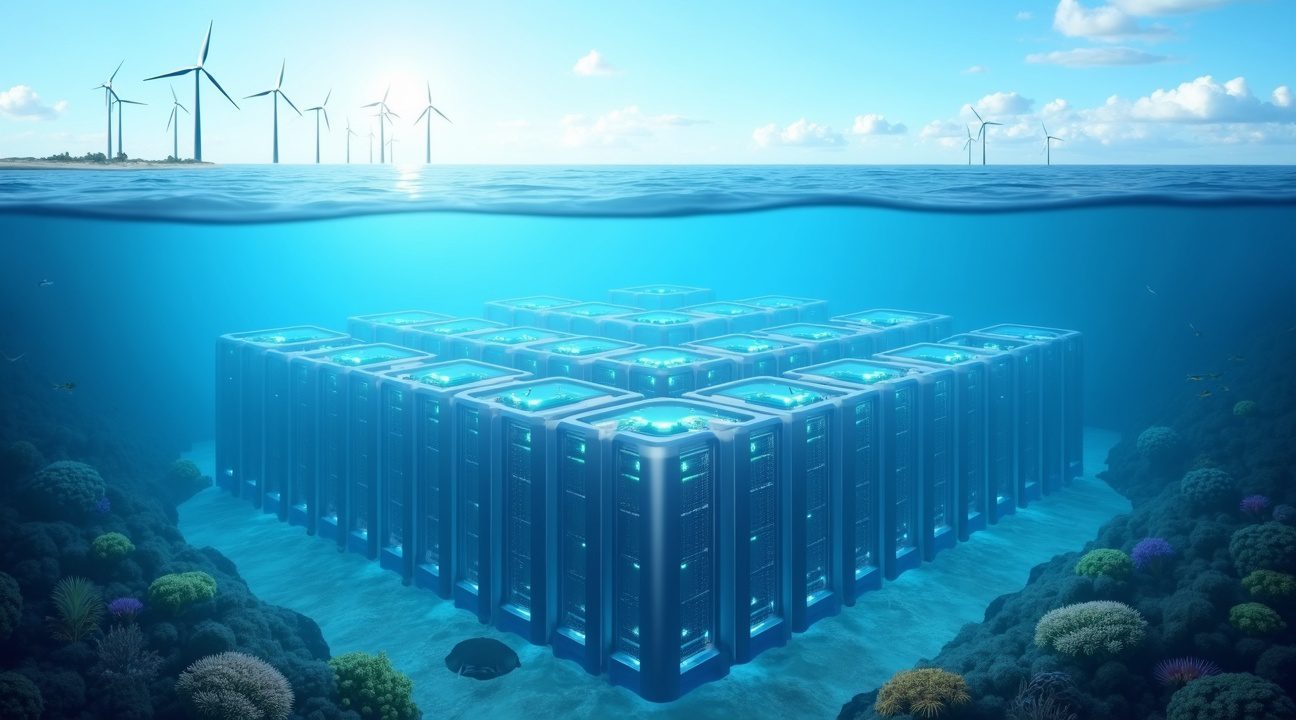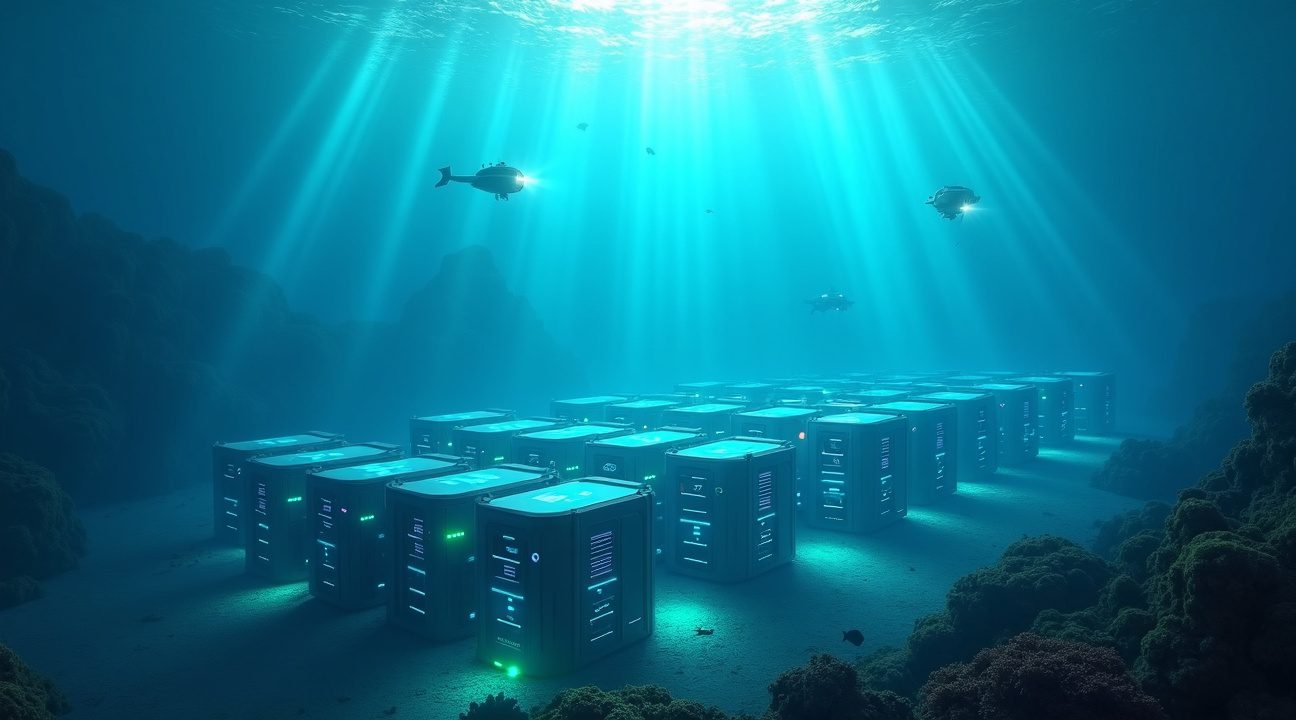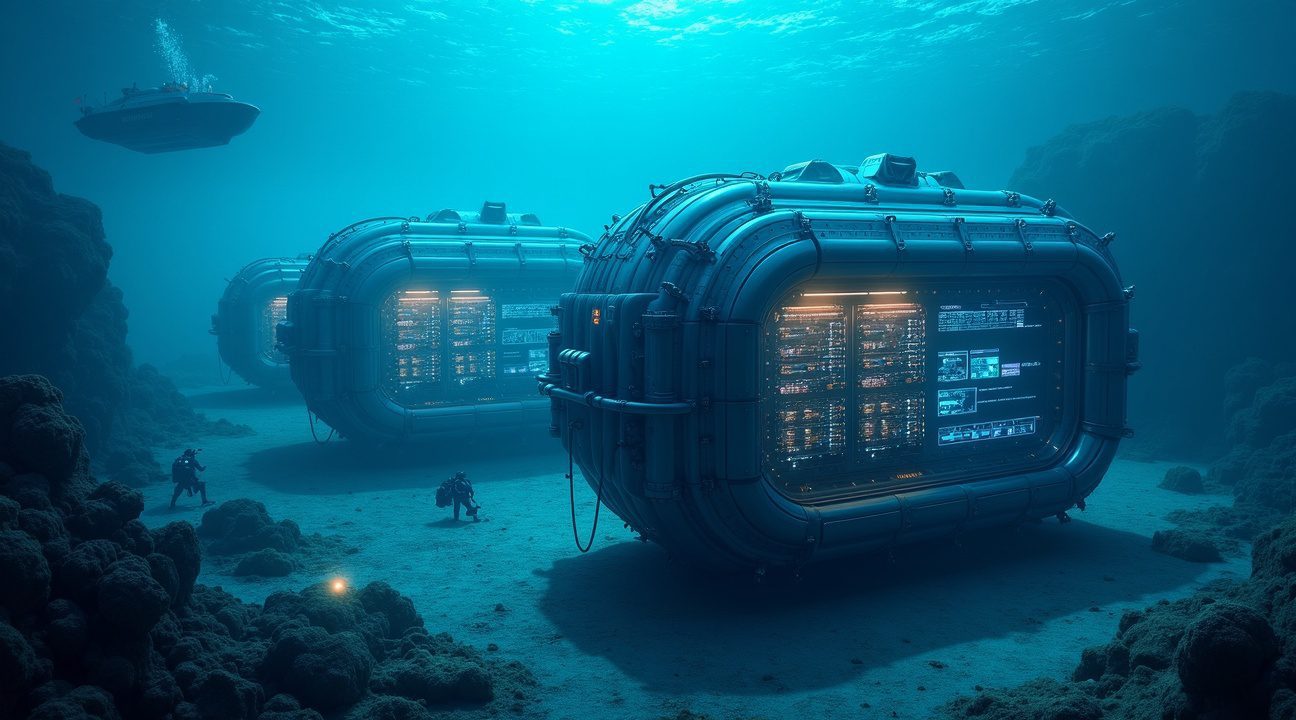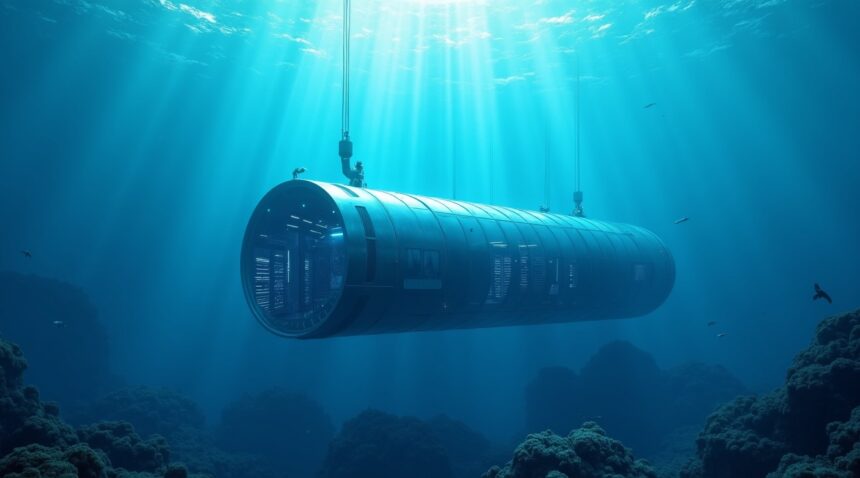China has created a technological milestone by launching the world’s first commercial underwater data center, strategically located 35 meters beneath the ocean surface near Hainan Island.
Overview of the Underwater Data Center
This next-generation data facility was unveiled through a collaborative effort between Highlander (Beijing Highlander Digital Technology) and HiCloud. The 1,433-ton underwater sealed cabin houses 24 racks of servers capable of delivering the processing power of approximately 60,000 traditional computers. Impressively, the system can analyze more than 4 million high-definition images in just 30 seconds.
Key Takeaways
- Exceptional Energy Efficiency: The underwater data center boasts a Power Usage Effectiveness (PUE) of 1.15. Unlike traditional data centers that allocate 40–50% of power to cooling systems, this facility cuts that need to under 10% thanks to the natural cooling provided by ocean water.
- Commercial Breakthrough: While Microsoft’s Project Natick (2015–2020) remained a conceptual trial, China’s underwater facility has evolved into a fully operational, profit-generating venture, serving clients like China Telecom and SenseTime.
- Environmental Advantages: When fully equipped with 100 modules, the system is projected to save 122 million kilowatt-hours of electricity annually, conserve 105,000 tons of freshwater, and spare 68,000 square meters of valuable coastal land.
- Advanced Applications: Designed for intensive computing demands, the system supports AI model training, high-performance computing needs, cloud gaming platforms, marine research computing, and 5G network infrastructure.
- Scalable and Sustainable Design: The modular structure of the data center allows expansion to 100 units, establishing a potential 24MW powerhouse with a 25-year operational life—a significant infrastructure for the future of underwater computing.
Looking Ahead
This innovative project not only reflects China’s drive to advance its digital economy but also signifies a new era in sustainable and space-efficient computing infrastructures. The implications of deploying data hubs beneath the ocean surface open the door to revolutionary advancements in cooling technologies, environmental conservation, and digital scalability.
Massive 1433-Ton Underwater Data Center Goes Live 35 Meters Below Ocean Surface
China made history on March 13, 2025, by launching the world’s first commercial underwater data center off the coast of Hainan Island. The groundbreaking facility features a massive 1,433-ton sealed cabin that sits 35 meters beneath the ocean surface, marking a revolutionary approach to data center infrastructure.
Highlander (Beijing Highlander Digital Technology) partnered with HiCloud to deploy this innovative underwater facility. The sealed cabin contains 24 server racks with capacity for 400 to 500 servers, delivering processing power equivalent to 60,000 traditional computers. This impressive computational capacity enables the facility to process over 4 million high-definition images in just 30 seconds.
Industry Partners and Technical Implementation
Several key companies collaborated to bring this underwater data center to life:
- HiCloud serves as the primary facility operator, managing day-to-day operations
- Offshore Oil Engineering Co (COOEC) handled the complex engineering requirements
- Sinnet oversees data operations and management
- Major customers include China Telecom and SenseTime
The underwater location offers significant advantages over traditional land-based data centers. Ocean temperatures provide natural cooling, dramatically reducing energy consumption typically required for air conditioning systems. This cooling efficiency could transform how the industry approaches thermal management in data processing facilities.
The 35-meter depth provides protection from surface weather conditions while maintaining accessibility for maintenance operations. The sealed design ensures complete waterproofing of sensitive electronic equipment while allowing for controlled environmental conditions inside the cabin.
This deployment represents a major shift in data center design philosophy. Rather than building massive facilities on valuable land, companies can now consider ocean floor installations that leverage natural cooling and reduce environmental impact. The success of this project could inspire similar underwater data centers in other coastal regions.
The facility’s ability to match the processing power of thousands of traditional computers in a compact underwater package demonstrates the potential for high-density computing solutions. This efficiency becomes particularly valuable as demand for artificial intelligence and machine learning applications continues to grow.
Ocean-based data centers also address land scarcity issues in densely populated areas. Coastal cities struggling with limited space for large data center complexes could benefit from offshore alternatives that don’t compete with residential or commercial development.
The partnership between technology companies and offshore engineering specialists highlights the interdisciplinary approach required for such innovative projects. COOEC’s expertise in underwater construction proved essential for creating a facility that can withstand ocean pressures while maintaining optimal operating conditions for sensitive computing equipment.
Ocean Water Cooling Slashes Energy Consumption by 75 Percent
China’s underwater data center represents a breakthrough in energy efficiency through its innovative ocean water cooling system. Traditional data centers typically consume 40 to 50 percent of their total energy for cooling operations alone. This underwater facility reduces that figure to below 10 percent by harnessing the ocean’s natural cooling properties.
The facility achieves a Power Usage Effectiveness (PUE) rating of no higher than 1.15, significantly outperforming China’s national guideline requiring new large data centers to maintain PUE levels below 1.25 by the end of 2025. This remarkable efficiency stems from the ocean’s stable temperature environment, which eliminates the need for energy-intensive air conditioning systems.
Massive Resource Conservation Through Smart Positioning
The full deployment of 100 planned modules will deliver substantial environmental benefits. The facility is expected to save 122 million kilowatt-hours of electricity annually, demonstrating how smart technology can transform energy consumption patterns. Additionally, the system will conserve 105,000 tons of freshwater each year by eliminating traditional cooling tower requirements.
Land conservation represents another significant advantage, with the underwater design saving 68,000 square meters of valuable coastal real estate annually. This space-saving approach addresses the growing challenge of finding suitable locations for large-scale data infrastructure.
Strategic positioning near offshore wind farms and other green energy sources enhances the facility’s sustainability profile. Future development phases target renewable energy usage approaching 97 percent, positioning the facility as a model for environmentally responsible data center operations.
Ocean water cooling transforms data center economics by dramatically reducing operational costs while maintaining optimal performance conditions. The technology leverages natural temperature regulation, where deep ocean water maintains consistent temperatures year-round, eliminating seasonal efficiency variations that plague land-based facilities.
I’ve observed how this innovation could reshape the industry’s approach to cooling infrastructure. The combination of reduced energy consumption, water conservation, and land savings creates a compelling case for underwater data center deployment in coastal regions worldwide. Projects like this demonstrate how advanced technology can solve multiple environmental challenges simultaneously.
The facility’s proximity to renewable energy sources creates synergies that amplify environmental benefits beyond direct cooling savings. This integrated approach to sustainable infrastructure development points toward a future where data centers contribute to rather than detract from environmental goals.

China Beats Microsoft to First Commercial Underwater Data Center
Microsoft pioneered underwater data center technology through Project Natick, which ran experimental deployments from 2015 to 2018 before officially concluding in 2020. While Microsoft’s initiative demonstrated the technical feasibility of subsea computing infrastructure, it remained purely experimental throughout its operational period.
China has now claimed the distinction of launching the world’s first commercial underwater data center, moving beyond experimental phases into actual business operations. This achievement represents a significant milestone in data center innovation, as the Chinese facility operates as a revenue-generating commercial venture rather than a research project.
Competitive Landscape in Underwater Computing
Several companies are racing to develop similar underwater data center technologies, though none have achieved commercial status yet. Subsea Cloud and NetworkOcean are advancing their own underwater computing projects, but these remain in development phases. Microsoft’s Project Natick deployment featured 855 servers during its experimental run, establishing a benchmark for underwater computing capacity.
The Chinese facility takes a modular approach, supporting up to 500 servers per module with ambitious plans to deploy 100 modules. This scalable design could potentially accommodate 50,000 servers across the full installation, significantly exceeding Microsoft’s experimental capacity. Both the Chinese and Microsoft facilities operate at approximately 35 meters underwater, matching the depth Microsoft tested at its Scotland site.
The operational depth of 35 meters appears optimal for underwater data centers, providing sufficient water pressure for cooling efficiency while remaining accessible for maintenance operations. This depth also minimizes interference with shipping traffic and fishing activities. The Chinese project’s commercial success validates the depth choice Microsoft established during its experimental phase.
Unlike Microsoft’s research-focused approach, the Chinese deployment emphasizes immediate commercial viability and scalability. The modular design allows for incremental expansion based on demand, making it attractive for businesses seeking flexible computing infrastructure. This commercial focus distinguishes China’s project from previous experimental efforts and positions it as a viable alternative to traditional land-based data centers.
The transition from experimental to commercial underwater data centers marks a critical evolution in the industry. While autonomous systems handle many operational aspects, the Chinese facility demonstrates that underwater computing can generate actual revenue rather than just research insights. This success could accelerate development of similar projects worldwide, potentially reshaping how companies approach data center infrastructure and cooling solutions.

AI Model Training and High-Performance Computing Drive Primary Applications
The underwater data center’s architecture specifically accommodates the intensive computational demands of artificial intelligence model training and inference operations. These massive steel pods house specialized hardware configurations that can handle the parallel processing requirements essential for training large language models and computer vision systems. Unlike traditional data centers that struggle with cooling costs for AI workloads, the marine environment provides natural temperature regulation that keeps processors operating at optimal performance levels.
High-performance computing applications represent another core use case for this submerged facility. Scientific simulations, weather modeling, and complex mathematical calculations benefit from the stable underwater environment where temperature fluctuations don’t disrupt sensitive computational processes. Industrial simulation workloads also leverage this platform, allowing manufacturers to test product designs and manufacturing processes in virtual environments before physical implementation.
Diverse Workload Support Across Multiple Industries
The facility’s modular design supports several additional applications that showcase its versatility:
- Cloud gaming services that require low latency and consistent performance for real-time interactive experiences
- Marine research computing that processes oceanographic data collected from surrounding sensors and monitoring equipment
- 5G network infrastructure that handles massive data throughput from mobile devices and connected systems
- Internet of Things processing for smart city applications and industrial monitoring networks
- E-commerce platforms that manage transaction processing and customer data analytics
China Telecom leads the roster of primary users, utilizing the facility for telecommunications infrastructure and network optimization. SenseTime, a prominent AI company, conducts machine learning model development and testing within these underwater modules. Regional pilot free-trade zone enterprises have also secured access to process international commerce data and run cross-border transaction systems.
Marine science organizations represent a unique user category, taking advantage of the facility’s oceanic location to conduct real-time oceanographic research while simultaneously using the computing power for data analysis. This dual-purpose approach maximizes the value of the underwater infrastructure investment.
The modular construction process demonstrates remarkable engineering precision. Each pressure-resistant steel pod undergoes complete assembly and testing on land before transportation to the deployment site. Engineers equip these watertight modules with all necessary computing hardware, cooling systems, and networking equipment while maintaining atmospheric pressure conditions. This land-based preparation ensures that all systems function correctly before the challenging submersion process begins.
Transportation involves specialized marine vessels capable of handling the 1433-ton cabin weight while maintaining the structural integrity of the sensitive electronic components inside. Once positioned at the designated underwater location, the modules connect to submarine power cables and fiber optic networks that link them to terrestrial internet infrastructure.
The pressure-resistant design allows these modules to operate at significant depths where hydrostatic pressure would typically crush conventional electronics housing. Advanced materials and engineering techniques create an environment where standard server hardware can function normally despite the extreme external conditions. This approach eliminates the need for specialized underwater electronics while maintaining compatibility with existing software and applications.
Maintenance procedures require careful coordination between marine operations and technical teams. Divers and remotely operated vehicles conduct external inspections, while internal system monitoring occurs through network connections to surface-based control centers. This hybrid approach balances safety considerations with operational efficiency requirements.
The success of this deployment could influence future technological innovations in distributed computing infrastructure. As organizations seek alternatives to traditional data center locations, underwater facilities might become more common for applications that benefit from natural cooling and reduced land use requirements.
Each module operates independently while maintaining network connectivity to create a distributed computing environment that can scale based on demand. This flexibility allows different organizations to utilize separate modules while sharing the overall infrastructure investment and operational costs.

Engineering Challenges and 25-Year Operational Lifespan
Creating data centers that can operate underwater for 25 years presents unprecedented engineering challenges that push technology to its limits. Each module requires sophisticated watertight enclosures capable of withstanding immense water pressure while maintaining perfect seals against corrosion for over two decades. Engineers have developed specialized materials and coating systems that resist saltwater’s destructive effects, ensuring critical components remain protected throughout their operational life.
Maintenance and Remote Operations
Remote monitoring systems become essential when data centers sit beneath the ocean’s surface. These facilities employ advanced sensors and automated systems that can detect problems before they become critical failures. When repairs are necessary, technicians face two primary options:
- Retrieving entire modules from the seafloor using specialized lifting equipment
- Deploying underwater robotics and diving teams for on-site maintenance
- Utilizing remotely operated vehicles (ROVs) for routine inspections and minor repairs
- Implementing hot-swappable components that can be accessed through pressure-sealed access ports
The engineering team has designed modular systems that allow for component replacement without compromising the entire enclosure’s integrity. This approach significantly reduces maintenance costs and minimizes operational downtime compared to traditional surface-based facilities.
Environmental considerations play a crucial role in the facility’s design and operation. Local temperature changes occur as servers generate heat, potentially affecting marine ecosystems in the immediate vicinity. Engineers have incorporated thermal management systems that distribute heat more evenly across larger areas, reducing concentrated thermal impacts. Marine biodiversity disruptions remain a concern, though the facility’s designers argue that underwater installations create artificial reef structures that can actually enhance local marine life over time.
The ambitious Phase 2 expansion demonstrates China’s commitment to scaling underwater data center technology. Plans call for increasing the site’s total power capacity from the current 2.3MW to an impressive 24MW, representing more than a ten-fold increase in computing capability. This expansion will require additional modules and enhanced power distribution systems that can operate reliably in the marine environment.
Power delivery to underwater facilities requires specialized submarine cables and pressure-resistant electrical systems. Engineers have developed redundant power pathways to ensure continuous operation even if one system fails. Cooling systems take advantage of the ocean’s natural temperature regulation, potentially reducing energy consumption compared to traditional air-cooled data centers that require extensive HVAC systems.
The facility’s 25-year operational target represents a significant engineering achievement, especially considering the harsh marine environment’s constant challenges. Saltwater corrosion, pressure variations, and potential storm damage all threaten equipment longevity. Success depends on rigorous testing protocols and materials science advances that weren’t available when innovative transportation technologies first emerged in other industries.
Scaling to 100 Modules Could Create Major Green IT Hub
China’s underwater data center project represents far more than a single prototype installation. Ambitious expansion plans call for scaling the facility to 100 modules, transforming this experimental venture into a substantial green IT and artificial intelligence computing hub that could reshape how the industry approaches sustainable infrastructure.
Massive Processing Power Through Modular Expansion
Each 1433-ton cabin serves as a building block in what could become one of the world’s most powerful underwater computing complexes. When scaled to 100 modules, the facility would deliver unprecedented processing capabilities while maintaining the inherent cooling and energy efficiency advantages of subsea operations. This modular approach allows for gradual expansion based on demand, making it both financially viable and technically manageable.
The scalability factor distinguishes this project from traditional land-based data centers that often face constraints related to cooling infrastructure, power grid limitations, and real estate availability. Advanced computing systems require massive processing power, and underwater facilities can accommodate this demand without the typical environmental compromises.
Positioning China as a Subsea Computing Leader
This expansion strategy reinforces China’s commitment to establishing dominance in subsea computing infrastructure. By demonstrating the viability of large-scale underwater data centers, the country positions itself at the forefront of a technology that could revolutionize how global digital infrastructure operates. The success of this 100-module facility would likely inspire similar projects worldwide, with China holding the technical expertise and operational experience to lead this emerging market.
Future development phases maintain strict adherence to sustainable operations principles. Each new module will integrate renewable energy sources, potentially including offshore wind and tidal power generation systems that complement the underwater location. This approach ensures that expansion doesn’t compromise the environmental benefits that make subsea data centers attractive alternatives to conventional facilities.
The integration of smart technology systems throughout the expanded facility will enable real-time monitoring and optimization of energy consumption, cooling efficiency, and computing performance. These intelligent management systems become increasingly critical as the facility grows, ensuring that each module operates at peak efficiency while contributing to the overall performance of the complex.
Energy sustainability remains a cornerstone of the expansion strategy. Unlike traditional data centers that consume enormous amounts of electricity for cooling systems, the underwater environment provides natural temperature regulation. This advantage becomes exponentially more valuable as the facility scales, potentially reducing energy consumption by significant percentages compared to equivalent land-based installations.
The economic implications of successful scaling extend beyond the immediate facility operations. A 100-module underwater data center would create a new category of infrastructure investment, potentially attracting international partnerships and establishing new standards for sustainable computing. The project’s success could influence how governments and corporations approach large-scale digital infrastructure development, particularly in coastal regions where underwater installations become feasible alternatives.
Technical challenges associated with maintaining and servicing 100 underwater modules require innovative solutions that push the boundaries of marine engineering and remote operations technology. However, these challenges also drive technological advancement that benefits broader industries, from offshore energy to marine research.
The facility’s role as an AI compute hub becomes particularly significant at scale. Advanced robotics and machine learning applications demand consistent, high-performance computing resources that underwater data centers can provide without the environmental impact associated with traditional facilities.
China’s strategic approach to this expansion demonstrates a long-term vision that extends beyond immediate technological achievements. By establishing the world’s first commercial-scale underwater computing hub, the country creates a foundation for future innovations in sustainable digital infrastructure while positioning itself as the global leader in subsea computing technology.
Sources:
AKCP: “Diving into the Future: China’s First Underwater AI Data Center and the Rise of Subsea Computing”
Data Center Dynamics: “China deploys 1,400-ton commercial underwater data center”, “China’s underwater data center expanded”
New Atlas: “World’s first wind-powered underwater data center has been unveiled”
Data Centre Magazine: “An industry boom: China and the underwater data centre”
Dgtl Infra: “Underwater Data Centers: Servers Beneath the Surface”
Interesting Engineering: “World’s first commercial underwater data centre goes live in China”
TechTarget: “Explore underwater data centers’ viability, sustainability”
Developing Telecoms: “China claims first commercial underwater data centre”
Freethink: “The future of data centers — on land, at sea, and in space”
Mezha.ua: “China launches world’s first commercial underwater data center”


